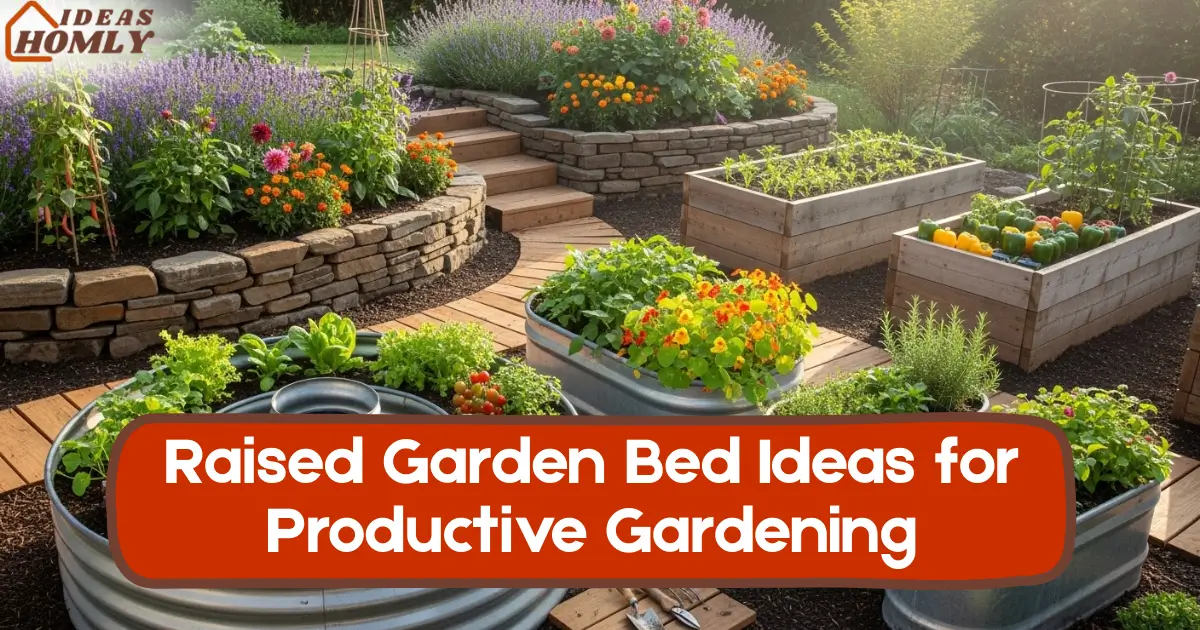Raised garden beds changed the way I think about gardening. They keep the soil loose, protect plants, and make gardening far more enjoyable. With the right setup, you save water, reduce weeds, and even extend your growing season.
In this guide, I’ll share seven raised garden bed ideas that actually work for productive gardening. Each one has its own benefits, and I’ll explain how you can build or buy them to suit your space.
1. Keyhole Bed with Central Compost Basket
The keyhole raised bed is one of my favorites because it almost feels like the garden feeds itself. The design includes a round or square bed with a narrow path that leads into the center, forming a keyhole shape.
In the middle, a compost basket holds kitchen scraps, leaves, and garden waste. As the compost breaks down, nutrients spread into the surrounding soil.
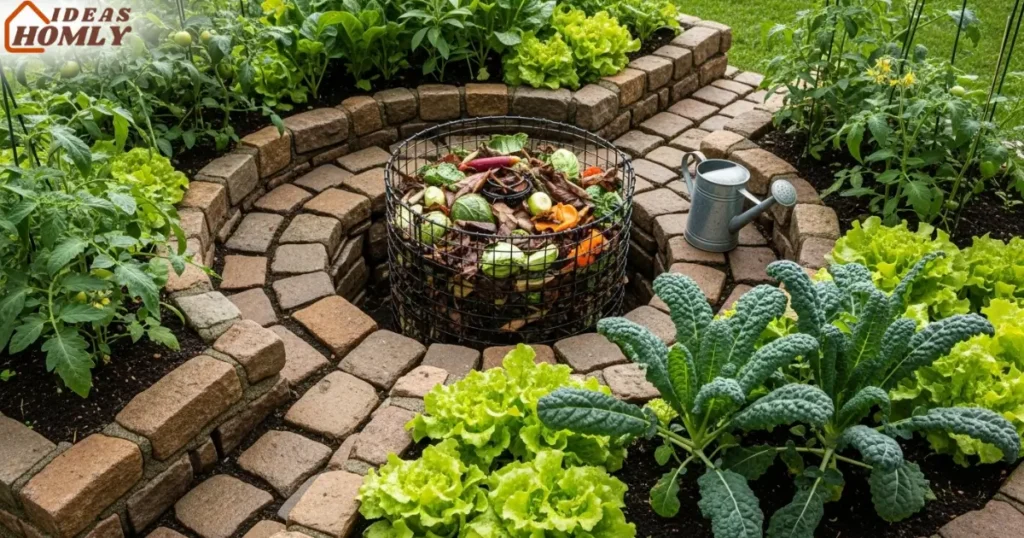
This setup is perfect for crops that thrive on rich soil such as tomatoes, lettuce, kale, and peppers. Since the compost releases steady nutrients, plants often need less fertilizer. It also makes watering easier because moisture from the compost basket spreads naturally.
Building one isn’t complicated. You’ll need bricks, wood, or stone to form the bed. The compost basket can be made from wire mesh or even a repurposed bucket with holes.
Once set up, it’s surprisingly low-maintenance because the garden keeps replenishing itself.
Benefits of a Keyhole Bed
| Benefit | Why It Matters |
|---|---|
| Built-in composting | Reduces fertilizer needs |
| Easy watering | Moisture spreads evenly |
| Space-saving | Works well in small yards |
2. Hugelkultur Raised Bed
Hugelkultur looks unusual at first but is brilliant once you understand it. Instead of filling your raised bed entirely with soil, you start with a base of logs, branches, and brush. Then you add compost, topsoil, and mulch over it.
Over time, the wood breaks down and creates a sponge-like core that holds water and releases nutrients.
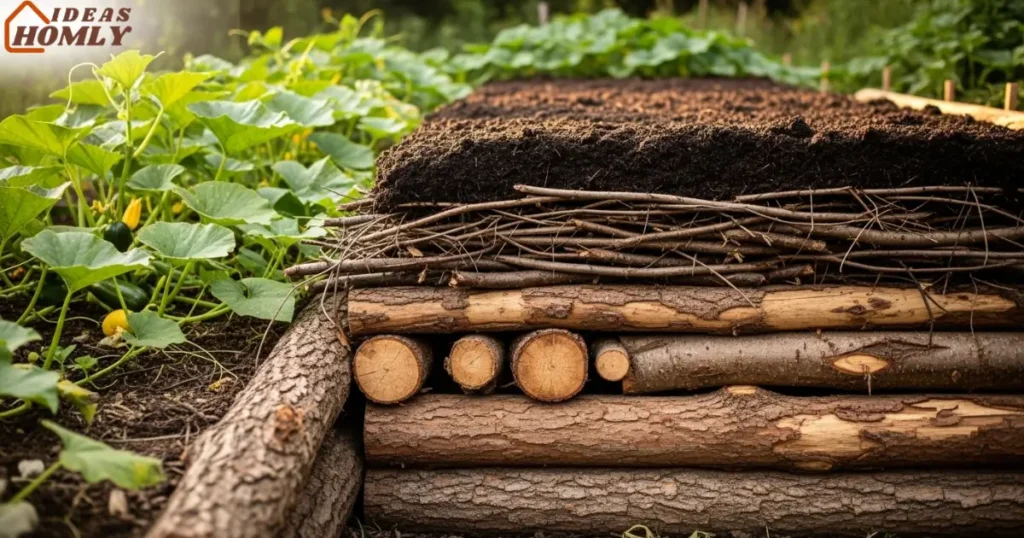
This is especially useful in dry areas because the logs keep the soil moist for longer. Crops like squash, cucumbers, and pumpkins thrive here since they need lots of water and nutrients.
The slow release of organic matter keeps the soil fertile for years without much effort.
To build one, collect logs that aren’t treated with chemicals, place them at the bottom, and layer smaller branches and organic matter on top. Add a thick layer of compost and soil to finish.
While it requires more effort at the start, the long-term benefits easily outweigh the work.
I’ve seen hugelkultur beds last up to 7–10 years without major rebuilding. That’s a big win for anyone who doesn’t want to constantly replace soil.
3. Self-Wicking Raised Bed with Reservoir
If you forget to water your garden sometimes (guilty here), a self-wicking raised bed is a lifesaver.
The idea is simple: you create a water reservoir at the bottom of the bed. A pipe or tube allows you to fill it, and the soil draws water upward as plants need it.
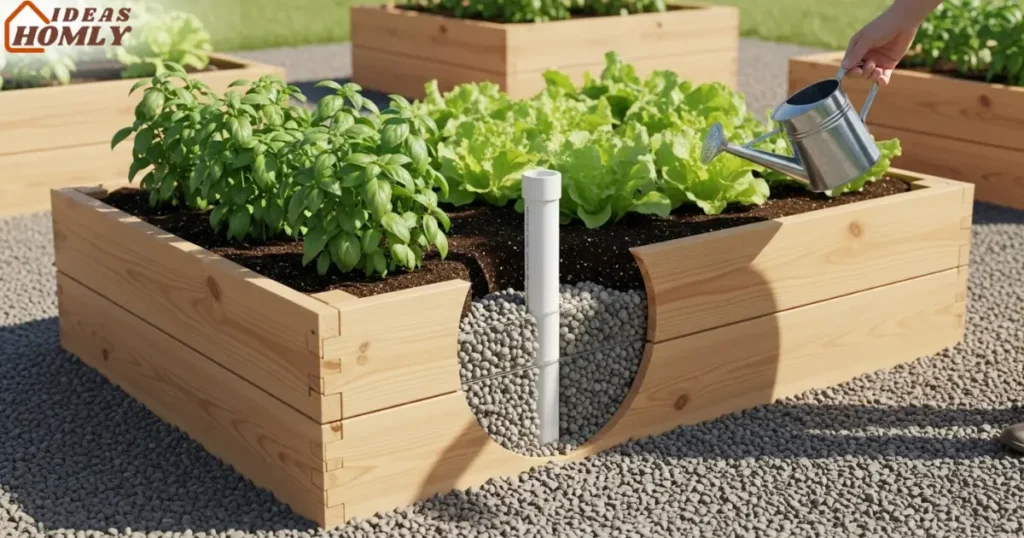
This system prevents overwatering and underwatering. It’s especially helpful for crops like lettuce, basil, and strawberries, which prefer consistent moisture.
You can even leave for a few days without worrying about wilted plants greeting you when you return.
To build one, you’ll need a sturdy liner, gravel, a water pipe, and good-quality soil. The reservoir usually holds several gallons of water, reducing the need for daily watering.
Some gardeners even repurpose storage totes or plastic containers for small self-wicking beds.
Why Choose a Self-Wicking Bed?
- Saves time on daily watering
- Prevents drought stress on crops
- Great for busy gardeners or small patios
4. Galvanized Stock-Tank Beds for Instant, Durable Planters
Stock-tank raised beds are probably the fastest way to set up a garden. These metal tubs, often used for watering livestock, make excellent planters because they’re strong, rust-resistant, and last for years.
I like them because you don’t have to spend hours hammering boards together. Just drill a few drainage holes at the bottom, fill with soil, and you’re ready to plant.
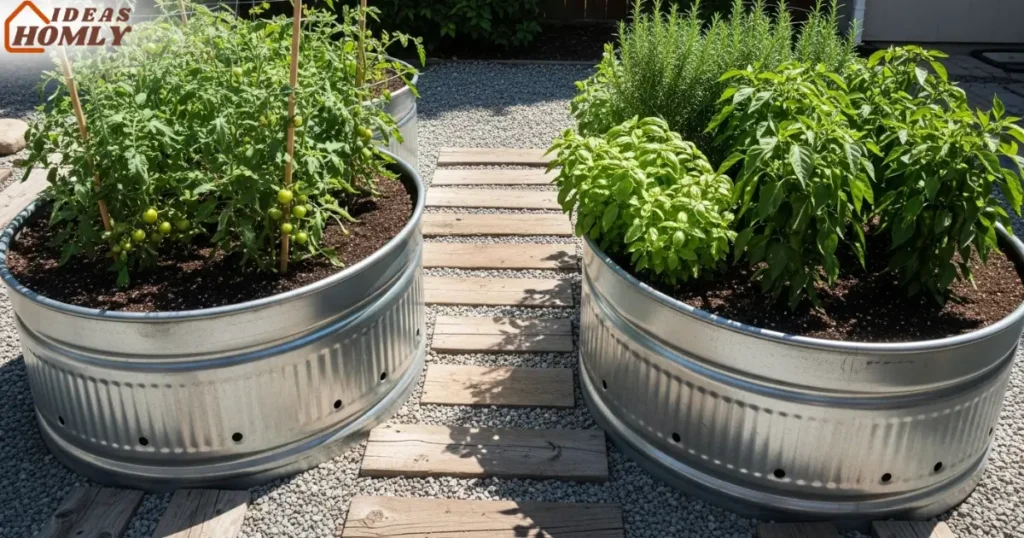
They look modern and tidy, which works well if you want both beauty and productivity in your backyard. I’ve seen people grow everything from herbs to tomatoes and even small fruit trees in them.
The depth supports deep-rooted plants, while the metal walls warm up quickly in spring, helping crops like peppers and beans grow faster.
If you’re considering cost, one tank usually covers a lot of space and saves you from buying separate wood or stone. They also move surprisingly well with help, so you can change your garden layout later if you want.
5. U-Shaped Layout for Ergonomic Access
A U-shaped raised bed feels like the garden was designed around you. Instead of stretching awkwardly or stepping on the soil, you can walk right into the middle aisle and comfortably reach every corner. This design makes planting, weeding, and harvesting far less tiring.
I’ve noticed U-shaped beds are especially helpful for people with back problems or limited mobility.
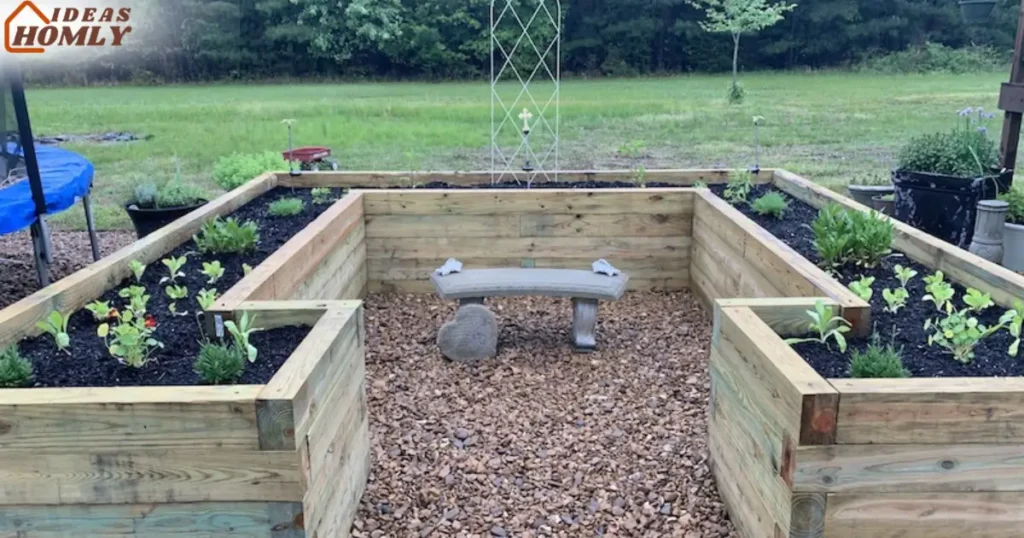
You can sit on a small stool in the aisle and still manage the whole garden without straining. Crops like greens, carrots, and herbs work beautifully here since you’ll be harvesting them often.
To build one, measure a space that leaves a wide enough aisle for walking. Wood frames are common, but bricks or stone also look great. If you want to make it even easier, you can build the sides taller to reduce bending even more.
Pros of a U-Shaped Raised Bed
| Advantage | Benefit |
|---|---|
| Central aisle | Easy access |
| Efficient space | More planting area in small yards |
| Comfortable design | Reduces bending and strain |
6. Tiered or Terraced Beds for Slopes
If your yard isn’t flat, a tiered or terraced raised bed can transform it into productive space. Instead of fighting the slope, you work with it by building stepped beds.
Each level holds soil in place and prevents erosion, while also giving you an organized planting area.
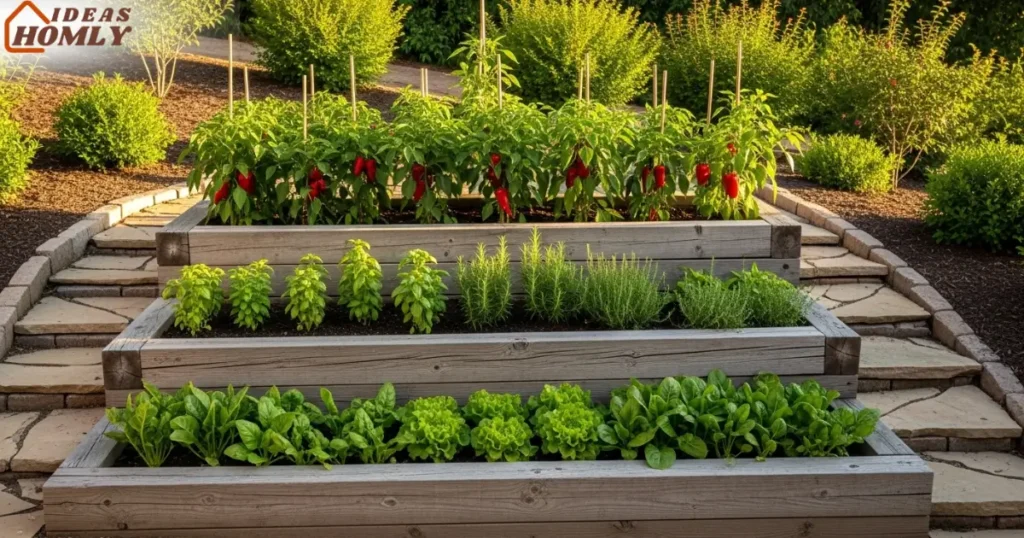
This layout looks stunning because it creates a layered garden view. Crops that need more sun, like peppers, can go on the higher tiers, while moisture-loving plants, like lettuce or spinach, fit better on the lower levels where water naturally collects.
Building one usually involves wood, stone, or concrete blocks to support each tier. It does take more planning than a simple box, but the result is a beautiful garden that solves drainage problems while giving you extra growing space.
I’ve found this style especially rewarding if you want to mix flowers with vegetables. The cascading look makes your garden double as landscaping.
7. Hoop-House or Cold-Frame Lids on Beds for Season Extension
One of the best tricks I’ve learned for year-round gardening is adding hoop-house lids or cold frames on raised beds.
By simply arching PVC pipes or metal rods over the bed and covering them with plastic, you create a mini greenhouse. Cold frames work similarly but use clear panels or old windows hinged on top of the bed.
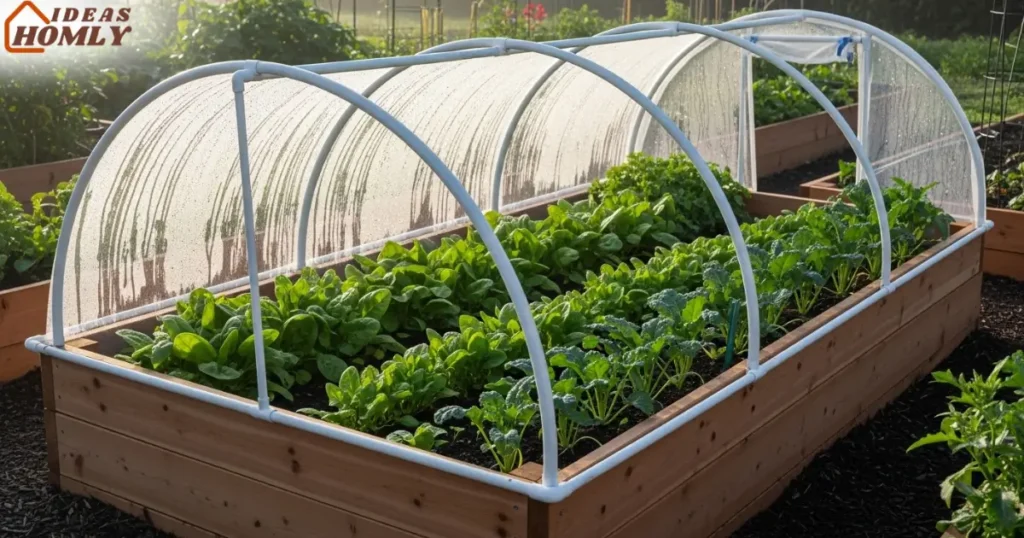
These covers protect plants from frost, wind, and heavy rain. They also trap warmth, so you can start crops earlier in spring and keep harvesting later in fall.
Leafy greens like spinach, arugula, and kale love this setup because they handle cool weather but appreciate the extra protection.
You can build a hoop-house with affordable materials, or buy ready-made kits online.
What I like most is the flexibility, you can remove the cover during summer and replace it when the nights get chilly again. It’s a simple upgrade that stretches your harvest and keeps pests away.
Conclusion
Raised garden beds don’t just look neat; they make gardening more productive and enjoyable. From keyhole beds that feed themselves to hugelkultur designs that hold water for months, each idea offers unique benefits.
Whether you need easy watering, slope control, or season extension, there’s a raised bed style that fits your needs.
I’ve tried different layouts, and the common advantage is clear: healthier plants and less hassle. If you’re short on space, stock-tank or U-shaped beds work great.
If you want long-term fertility, hugelkultur is unbeatable. And if you’re chasing year-round harvests, hoop-house lids make all the difference.
The key is to match your gardening goals with the right bed style. Once you do, your raised garden won’t just be productive, it will feel like an extension of your home.
FAQs
I’ve found untreated cedar and galvanized steel to be the most durable options. Cedar naturally resists rot and pests, lasting for years without chemicals.
Galvanized steel tanks or panels are equally long-lasting and need almost no maintenance. Both materials keep soil healthy and safe for edible crops.
Most vegetables grow well in 10-12 inches of soil. However, root crops like carrots or parsnips benefit from 16-18 inches of depth.
If you’re gardening on concrete or rocky soil, going deeper ensures roots grow freely without restrictions. Deeper beds also hold more moisture.
Yes, but it’s best to prepare the ground first. I usually lay cardboard or a thick weed barrier before adding soil.
This prevents grass and weeds from creeping up into the bed. Over time, the cardboard breaks down and improves the soil beneath the bed.
Watering depends on weather, soil type, and crops. In summer, raised beds dry faster than ground soil, so I usually water daily or every other day.
Self-wicking beds reduce the frequency since the reservoir keeps soil evenly moist. Mulching also helps lock in moisture.
Yes, and the difference can be surprising. Loose soil helps roots spread easily, which leads to healthier plants.
Beds also warm up faster in spring, extend the growing season, and reduce weed problems. These small advantages add up to higher yields with less effort.

